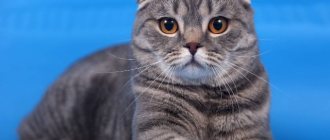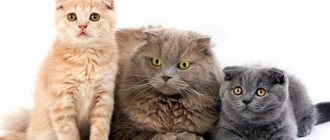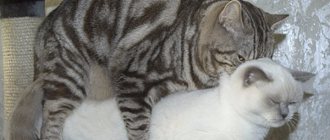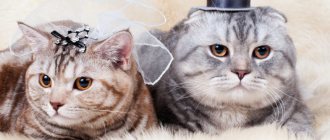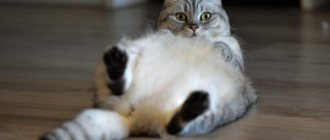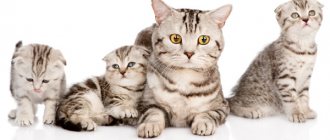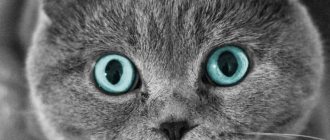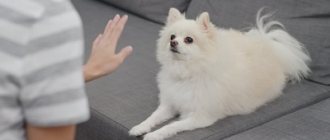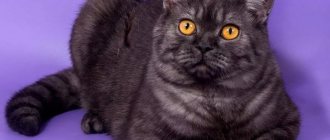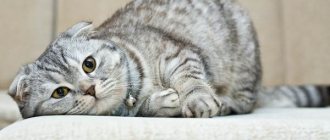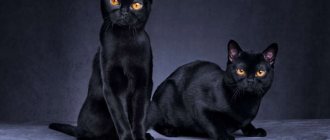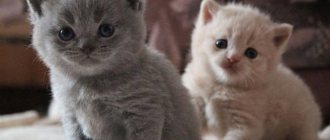If you ask the average person what color Scottish cats are, he will certainly answer that they are gray (the color among professionals is called blue). This is a common color of Scottish cats. But today the variety of colors is very large. Therefore, when asked what colors of Scottish cats there are, you must boldly answer: any! To get such a wide palette, Scots had to be crossed with other breeds. Today, interbreeding is not encouraged, because cats already have the necessary set of genes.
In this article we will answer the following questions: what color are Scottish kittens, what color are Scottish cats, what are the main genes that form the colors of Scottish Fold and Straight-eared cats (Scottish Straight, Scottish Fold, Highland Straight and Highland Fold). Also in the article we will talk about how the color of Scottish kittens changes with age, and show photos of Scottish cats and kittens of almost all colors. Absolutely all colors cannot be presented within the framework of the publication, because... there are a lot of them, and the genes, combining in a bizarre way, still surprise breeders.
Article continues after advertisement
Other breeds of blue screen star cats
“British” and “Scots” are far from the only TV stars.
For example, the face of the advertising campaign for Gourmet Gold food is a white Persian cat, and Sheba is represented by an elegant Russian blue cat. But to become a screen star, you don’t have to belong to any particular breed. The well-known cat Boris from the Kitiket advertisement is a mongrel, just like the ginger cat from the Friskies commercials. Advertising is one of the most important aspects of the success of any brand. But sometimes it brings not only fame to the company, but also an advertising hero. A striking example of this is the Whiskas advertising campaign, which popularized British and Scottish Shorthair kittens. Everyone dreams of having such a pet. The main thing is to accurately determine the breed and color.
Intelligence, learning skills
It is generally accepted that Scottish Fold cats are not only extremely charming and attractive, but also endowed by nature with extraordinary intelligence. High intelligence contributes to the assimilation of any new information, provided that it brings preferences to the cat. Simply put, he will learn to do only what will give him some benefit. If you take on this disastrous task of training a “Scot,” get him interested in the end result and only then start training.
Remember that the refined nature of the Scottish Fold does not tolerate shouting and harsh intonations at all, so train him with moderate severity. For cats (unlike dogs), harsh training methods are contraindicated. If you shout at the fold, you will end up with an incorrigible alarmist or an aggressor. The best way to train a Scottish Fold is through a fun game.
Care
Scots are low maintenance. Keeping them in order does not require much time or special skills.
Wool
Short-haired cats need to be brushed once a week. Long-haired dogs deserve a little more attention. Highland Folds tend to form tangles and swallow hair, so it is worth brushing them at least three times a week. Ideally - every day. To make the procedure easier, you can purchase a furminator.
Fold cats need to be bathed with special shampoos once every two months, long-haired cats - monthly. You should also purchase a paste to remove hair from the body.
Nutrition
As for nutrition, here, like with any other cats, there are three options:
Natural food. They use various types of lean meat (chicken, veal, rabbit) raw or boiled, fermented milk products, eggs and fish. Raw meat is taken only after preliminary freezing for a week, chopped and heated slightly warmer than room temperature.
Ready-made dry food and spiders
The main thing here is to pay attention to the composition. The lower the cost, the lower the percentage of meat content and the higher the percentage of cereals, starch and flour.
It is better to take premium food.
Combined nutrition. This option is two meals a day. In the morning, they give ready-made food, and in the evening, self-prepared food, or vice versa. But experienced breeders do not recommend sticking to this option due to the risk of developing problems with the digestive tract.
The cat is fed from a clean bowl. Free access to clean drinking water must also be ensured. It needs to be changed at least once a day.
Caring for ears, eyes and more
In addition to fur, other parts of the body also require care:
- Eyes are examined daily. If necessary, wipe with a damp swab.
- The ears are cleaned approximately once every two weeks using a swab dipped in water. Using cotton swabs risks damaging your ear.
- Teeth. If the pet is on ready-made food, then the need to brush its teeth disappears by itself, since hard food cleans the surface of the teeth from stone and plaque. For natural nutrition, pastes and brushes should be used. This should be done at least every other day.
- Nails are trimmed once every 2-3 weeks. We have previously written about how to properly trim a cat’s claws.
- Animals need to be treated for worms and fleas twice a year.
Walking your pet
The Scottish Fold is suitable for keeping in any room, be it a private house or apartment. Whether or not to let an animal go outside for a walk is at the discretion of the owner.
If the decision is left to keeping the animal outside, then be sure to ventilate the room so that the animal gets fresh air. If the cat goes for a walk, then, in order to avoid loss, you can wear a collar with a capsule for the address and phone number or implant a chip.
Color-pont
This type of color is considered rare among Scottish Fold cats. Folds owe their elite coloring to their British ancestors, who had Persians with a similar color in their family. The cat's body is light, and all protruding parts (ears, muzzle, tail, paws) are painted in brighter colors, forming an effective contrast with the main color shade.
Features of marble color, types
The fur of a Scottish marbled cat looks very impressive. There are several general features of the drawing:
- the presence of dark lines on a light background;
- bright arrows coming from the outer and inner corners of the eye;
- the letter "M" on the forehead;
- hairs at the base are light, darkening towards the tips;
- striped tail (wide rings);
- bright stripes on the neck and chest, framing them like a necklace;
- spots, circles on the sides, located symmetrically relative to the line of the spine.
Each individual type has its own color scheme. Black marble (another name is brown) has a warm beige background, and a dark brown pattern, almost black in places. The undercoat is light beige. The animal's eyes are a rich amber color, and its paw pads are black.
Marble on silver differs from the one described above in the color of the undercoat. On a light, silver background, dark spots look like a bright contrast. The color of a cat's eyes varies from amber to honey. There are individuals with green irises. Paw pads are black.
Blue marble has a bluish-grayish primary coat color. The peculiarity of the type is that the pattern is not as pronounced as that of the black or silver type. It's slightly blurry. The iris is amber. The color of the paw pads is grey.
If an animal has the pheomelanin gene, then the predominant coat color is red. These individuals include red marble. Red marbled kittens have a rich yellowish base color of fur, on which there is an orange pattern. The pigment is also present in the iris; it is yellowish-brown. The pads on the paws are soft pink.
The tortoiseshell species is especially interesting. It can only be seen in females. The organism of individuals combines two pigments: black and red. As a result, the animal looks like black marble, in which there are chaotically scattered red spots. Such “sunny” inclusions do not always make the pet attractive. You can see a spot on one of the toes. Tortoiseshell cats, respectively, give birth to black or red Scottish marbled offspring, so this species is a favorite of “cat lovers.”
Marble on gold is considered a rare color. The sheen of noble metal is provided by the undercoat. The drawing amazingly combines black and apricot colors. The iris of the eyes is green, the skin of the paw pads is black.
The chocolate shade contains different shades of brown. This is a very beautiful pet with amber eyes and brown paw pads. Breeders approach with particular scrupulousness the selection of a pair of marbled tabby cats, so that as a result amazing offspring are born.
Shaded
Currently very popular among breeders. With this type of color, 1/3 of the tip of the hair is colored, the rest is white. It is also characterized by bleached ends of the hair, light undercoat, shaded fur in the areas of the back, tail, head, ears, light chin, belly and base of the tail, tipping of the main color.
Among the shaded colors there are:
- Golden-cream undercoat, coat hairs have black tips.
- Silver - the undercoat is white, the tips of the main coat are gray and black.
- Red - white undercoat, main coat of bright red color, red “shading” on the sides, base of the tail, belly, muzzle and chin of a lighter shade.
Comparison with British cats
The Scottish Fold is not a British Shorthair breed. At the beginning of its history, the individual was mated with a Briton, which is why the kittens received external characteristics from the British and became similar to them: this is the color of the coat, its length and shape, eye color, and the size of the animal’s body. The exterior of the British cat differs from the Scots cat, although the British cat is just as large, the chin and cheeks of the animal are well defined. The difference in the two breeds can also be replaced in the structure of the paws. The Scots have them more graceful, thin, and long.
The easiest way to determine what kind of breed is in front of you is to look at the animal's ears. But keep in mind that Scots with straight ears are also almost no different from the British. All British cat kittens are born with erect ears. Scottish Straights are a Scottish breed because only a fold-eared cat can produce them in a litter. In fact, erect ears can be partly considered unique to this breed.
Pets are also distinguishable by their personalities. The British Shorthair breed is very aristocratic and arrogant; there may be some coldness towards its owners. She does not tolerate affection or squeezing. All these affections happen only with her permission, whenever she wants. The Scots, on the contrary, are extremely loving animals and are always happy to be stroked, play, and have various events.
Fold cats are not very active vocally, but they talk to their owner by purring. If you put two breeds of the same color next to each other and start talking and playing with them, it will immediately become clear which one is which.
Smoky
This coloring appears under the influence of the silver gene and is characteristic of folds whose guard hairs are solid in color - black (black smoke), red, lilac, blue. The base of the undercoat is silvery-white. Thanks to the contrast of shades, it seems that the cat’s fur coat has the color of a light foggy haze.
It should be noted that the smoky color is considered undervalued today; animals with this coat color are not allowed to participate in exhibitions. But breeders believe that smoky cats are among the most attractive folds.
About the breed
Based on the name, this breed first appeared in Scotland. However, some researchers claim that similar cats lived in eastern countries several hundred years ago. Fluffy cats look very much like British Shorthairs.
The characteristics of the breed include the following.
- Strong muscular body of correct proportions.
- Small head with a round muzzle. Outwardly, the Scot resembles a teddy bear.
- Short well developed neck.
- Massive limbs with soft paw pads.
- Expressive eyes. In most cases, this breed has orange eyes, but there are blue-eyed and green-eyed individuals.
- The Scottish coat is soft (plush) and shiny. The fur fits tightly to the body. There are short-haired and long-haired varieties of the breed.
- Adult cats weigh no more than 6 kg. Small kittens are especially adorable and resemble a soft toy.
The main feature of the breed is the shape of the ears. The fact is that Scottish cats are divided into several types: Scottish Fold and Straight (short-haired) and Highland Fold and Straight (long-haired). Straight cats have straight ears, while animals called fold have fold ears.
Tortoiseshell colors
It is an original combination of red and dark or cream spots. This should not be confused with the tri-color pattern, as the cream color in the tabby pattern is a bleached red. There is no clearly defined standard regarding tortoiseshell color; the only condition is that the distribution of colors must be harmonious.
It is noteworthy that only cats have the rare tortoiseshell color. In cats, it is observed only in cases of genetic failures; such individuals are incapable of reproducing offspring.
What to name a Scottish kitten
Many new owners of plush kittens prefer to follow the beaten path and give their pets well-known nicknames: Barsik, Murzik, Vaska. But for open-minded cat lovers, choosing a name for a boy or girl is a great way to show creativity and imagination.
What nickname can you come up with for your pet so that it is associated with Scotland? This is not difficult, because the history and culture of this country are known throughout the world. Kilt, bagpipes, whiskey, tartan - this is not a complete list of words that make us think of distant Scotland.
You can rack your brain and come up with a name based on the suggested words. But most often male kittens are named Scott (Scotty), Shot (Shotti), Valli, Rob, Roy, Baxter, Archie and even Holmes or Watson. The girls are called Foxy, Orange, Athena, Shakira, Martha, Chessie, Shaddy.
What to pay attention to
The attractive appearance, velvety coat and exclusive color, as well as the wonderful character of a straight-eared (straight) or fold-eared (fold) kitten play an important role in choosing a Scottish breed. But another task is to acquire a healthy pet with data that meets the standard.
When buying a Scotsman of any kind, pay attention to:
- Have all required age-related vaccinations been completed, and have preventive deworming been carried out? Kittens often become infected with worms in infancy.
- Well-groomed appearance of the mother, calm caring behavior.
- They observe the behavior of the selected kitten in the nest together with its brothers. It’s good to see character traits there: quiet or cocky, playful. The baby should not be aggressive or too timid. You can learn a lot about him while eating, what kind of appetite he has. One glance is enough to choose what you like.
- The selected baby is carefully examined. Particular attention is paid to the tail. Thick, short and curved, with painful tail vertebrae is a sign of a possible genetic disorder in the musculoskeletal system.
- A healthy pet's coat is shiny, soft, silky, and resembles velvet. There is no dandruff or bald patches with signs of contagious ringworm.
- After birth, when the kitten opens them, the eyes are always blue, expressive, clear, without signs of purulent discharge.
- At 3 months in Scottish kittens, when the ears droop, you can detect sulfur, but not dark discharge indicating the presence of mites, but purulent discharge occurs with otitis media.
- The mouth and gums are exclusively pink, the teeth are white. There should be no unpleasant odors from your mouth.
- The legs of the limbs should bend well and be mobile. The front ones grow 5 claws, the back ones 4.
- It is important that the tummy is not inflated, which indicates problems with housing and communal services or the presence of worms.
- Is the kitten accustomed to the tray and scratching post, which is important when caring for it.
- The pet's parents must be of the Scottish breed, but must be of different types: one straight-eared (straight), the other fold-eared (fold). It is prohibited to cross two folds.
It is not recommended to purchase a Scottish kitten:
- Outside the home, without assessing the baby’s behavior in familiar conditions.
- If the baby is less than 3 months old, he is breastfed.
- The pet does not have a healthy, sickly appearance; there is no fat accumulation under the fur, only skin and bones.
Scots colors
At the beginning, Scottish cats were not distinguished by a variety of colors and mainly bluish-gray tones predominated. After identifying them as a separate breed, breeders got to work and developed about 200 types of colors. The most common are:
- Solid color, solid. These are solid colors; according to the standard, they are not allowed to have spots, inclusions, all hairs of a foreign color, the undercoat is considered defective. Solids include:
- blue,
- gray, the most common color of fold-eared kittens.
- ebony, black British, endowed with magical properties by people, are considered a talisman, a talisman of the house
- chocolate, rare brown color;
- faun, have the color scheme of a young deer;
- lilac, unusually beautiful soft gray tone.;
- cinnamon, a relatively new milk chocolate color;
- creamy, the color resembles a fresh velvety peach;
- red, red genes are the basis of many tones.
- Bicolors are a combination of white fur and the main color. In this case, a white symmetrical pattern is located on the abdomen, at the bottom of the muzzle and at the ends of the legs.
- Tortoiseshell colors consist of dark and red spots; this color is considered rare and occurs only in cats. Tortoiseshell cats are considered mutants, they cannot have offspring
- Point color, when the main color is spread throughout the body, except for those places where the temperature is low and the hair on the tail, muzzle, and paws is darker.
- The tabby color in cats has an animal color similar to brindle, spotted, marbled and consists of stripes, spots, rings on a contrasting background. With a distinctive mark on the forehead in the form of the letter "M" or the sign of a scarab.
- The color point is similar to the Siamese, where the coat is light throughout the body and the face, ears, paws and tail are dark, brown or black. These cats have blue eyes.
- The harlequin color is distinguished by the fact that spots of other colors are scattered on the white background of the coat.
- Van color, in which the cats are white, but the face and tail are a different color.
- Shaded color, when each hair is colored one color underneath and another color on top
- Tacked color, when each fiber is painted in three colors, smoothly transitioning from yellow to brown.
- Marble color, when there is a butterfly pattern on the shoulders, three wide stripes running along the back, the lower belly is covered with spots.
Beliefs and signs about black cats
In England, where the lineage of fold-eared cats began, the attitude towards black animals is completely different from how they are perceived in eastern countries.
- In Scotland, meeting a black cat is considered a good omen.
- If a black cat enters someone else's house, it means that a happy surprise awaits its owners. This has been believed in the English provinces for many centuries. Therefore, a saucer of milk is often left near the house in case an unfamiliar four-legged guest arrives.
- Black cats are highly prized by British sailors. Since ancient times, such animals have been considered the best rat catchers. For the same reason, farmers selected black cats.
- For the fair sex, a black cat attracts suitors to the house and increases the girl’s chances of a successful marriage.
The black fur of fold-eared cats has not become the subject of a negative reputation for these cats. They look too funny to inspire fear or apprehension when you meet them. With good heredity and proper maintenance, Scots live up to 15 years.
They delight others with their gentle character, good disposition, sociability and impeccable politeness, which is inherent in real Englishmen.
I like3I don't like
Character
The entire Scottish breed is the work of human hands. Such pets are very attached to their owner. This suggests that even the smallest kitten will be cozy and comfortable in a new home, where he is loved and appreciated. You should know that a strongly developed habit can harm your pet. A long lack of attention or the owners leaving the house is a psychological trauma for a Scots cat.
By nature, Scottish cats are calm and balanced. They will not secretly shit in their slippers, but will prefer to silently move away from the aggressor. At the same time, cats have a developed sense of self-esteem; they will always show sympathy for the owner, but will also gently let him know when he has crossed the line. If a dog or another cat already lives in your house, the Scottish will treat this normally. Don’t be surprised when, after a while, a Scottish cat sleeps or plays with an adult dog.
Scottish cat color chart
Cats of the Scottish breed (Scottish Fold, Highland Fold, Scottish Straight and Highland Straight) are subject to the international color classification. It has symbols - numbers and letters. The code consists of:
1. Capital letters denoting the breed.
2. Lowercase letters indicating the primary color (blue, chocolate, etc.).
3. Pairs of numbers indicating the type of color (shaded, harlequin, Siamese, etc.) are numbers from 1 to 35.
4. Tail length - numbers from 51 to 54.
5. Eye color - numbers from 61 to 67.
6. Another additional pair of numbers can indicate the shape of the ears - 71 (straight ears of the Scottish Straight) and 73 (dropping and forward-curved ears of the Scottish Fold).
XXX.xx.NN.NN.NN.(NN)
xx - lowercase letter color designations:
| Designation | Colors |
| A | blue |
| b | chocolate, brown, chestnut (chocolate, brown, Havana, champagne) |
| With | lilac, lavender (lilac, lavender, platinum) |
| d | red, flame (red) |
| e | cream (cream) |
| f | tortoiseshell, patch (tortoiseshell) |
| g | blue-cream, blue-tortie (blue cream, blue tortoiseshell) |
| h | chocolate-tortie (chocolate tortoiseshell) |
| j | lilac-tortie (lilac tortoiseshell) |
| n | black, ebony, seal, sable, ruddy (black, ebony, seal, sable, wild) |
| o | sorrel, cinnamon, honey (sorrel, cinnamon, honey) |
| p | beige fawn (yellow-brown, beige) |
| q | sorrel tortie (red-brown tortoiseshell) |
| r | beige fawn tortie (beige tortoiseshell) |
| s | silver, smoke (silver, smoky) |
| w | white (white) |
| x | unregistered (unregistered color) |
| y | golden (golden) |
NN.NN.NN.(NN) - values of pairs of digits (up to three main and one auxiliary), starting with 0:
| Designation | Decoding |
| 01 | van (van) |
| 02 | harlequin (harlequin) |
| 03 | bicolour (two-color, bicolor) |
| 04 | mitted/white point (with white markings for color points) |
| 09 | little white spots (white spotting 1-2 cm) |
starting with 1:
| Designation | Decoding |
| 11 | shaded (shaded, i.e. 1/4 of the top part of the hair is darkened) |
| 12 | tipped, shell (veiled, i.e. 1/8 of the top part of the hair is darkened) |
starting with 2:
| Designation | Decoding |
| 21 | tabby, agouti (striation, agouti factor) |
| 22 | blotched, marble |
| 23 | mackerel, tiger (mackerel, tiger) |
| 24 | spotted (spotted) |
| 25 | ticked (ticked or Abyssinian) |
starting with 3:
| Designation | Decoding |
| 31 | burmese (Burmese) |
| 32 | tonkinese (Tonkinese) |
| 33 | himalayan or siam (Himalayan, Siamese, point) |
| 34 | singapura (Singaporean) |
| 35 | abyssinian (Abyssinian) |
starting with 6 (eye color):
| Designation | Decoding |
| 61 | blue |
| 62 | yellow, golden (yellow, orange, golden) |
| 63 | oddeyed |
| 64 | green |
| 65 | burmese (eye color of Burmese cats) |
| 66 | tonkinese (eye color of Tonkinese cats) |
| 67 | himalayan or siam (eye color of Himalayan and Siamese cats) |
For example, a fold-eared cat of color ps 24 is a cat of silver spotted fawn color. Thus, as you can see, the color code is formed from letters and numbers, but there are a lot of variations in the colors of Scottish breed cats, because... various factors combine to form countless variations. Within the scope of this article it is impossible to show absolutely all the colors of Scottish cats, cats and kittens.
Chinchillas
The Scots owe such expressive and beautiful colors to the British, who, in turn, borrowed it from the exotics and Persians. This rare color is found only if both the mother and father of the kitten are chinchillas. It is characterized by one-tone coloring of 1/8 of the coat area, the other areas of the coat are white.
Classification:
- Silver chinchilla. A peculiar combination of light undercoat and black “shading”. Snow-white ears, tummy.
- Golden. Individual areas of the body are “shaded” with intense fiery red. Tipped paws, muzzle.
- Golden (blue). The rare coloring is formed by the “baked milk” undercoat and bluish tipping with a shimmering shine.
Features of care
If you do manage to become the happy owner of a snow-white, blue-eyed miracle, you need to provide your pet with comfortable living conditions.
It is best to place a house for a kitten in a secluded place, protected from drafts, to which kittens are very sensitive. It is necessary to regularly examine the animal's eyes and nose, as watery eyes can be a sign of a cold. There is also a very high risk of developing bronchitis.
Scottish Folds quickly get accustomed to the tray, but for white animals its height must be chosen higher to avoid contamination of the paws and belly.
Snow-white wool will require more frequent bathing (for other colors, bathing is necessary once every 2 months), and detergents should be soft and neutral, without coloring ingredients and fragrances
After washing, wet wool should be carefully blotted with a towel and dried with a hairdryer to prevent dust from sticking.
A kitten needs a complete diet, rich in vitamins and microelements, which can contain natural food (lean meats, fish, boiled vegetables, cereals, dairy products) or premium food. If necessary, you can include various dietary supplements in your diet.
For information on the features of caring for cats of this breed, see the following video.
A bit of genetics
Many people are interested in learning how the colors of Scottish cats are formed. In Scottish cats, two genes predominate, responsible for black and red coat colors. Each of them can act as a dominant (suppressing weaker genes) and recessive (suppressed gene). And there is a third diluent gene, responsible for the saturation of the pigment. Combining in a certain order, these genes can give completely unimaginable coloring. If you are interested in the topic of the genetics of the colors of Scottish cats and what coloring results from crossing, come here. And we will continue.
The presence of one color or another in a Scottish kitten cannot always be determined in the first weeks of life. This is not the final shade yet, because the coloring becomes brighter and more pronounced only when the coat is replaced by an adult during the baby's molt. This happens around six months of age. But up to 2 years, the shade may still change slightly.
Breed varieties
The most famous are two varieties of the Scottish breed: Scottish Folds - incredibly popular plush cats with unusual ears - and the less popular Scottish Straights, whose ears stand upright. But it turns out that “Scots” are divided not only into these types. There are also Highland Straight and Highland Fold pets.
Scottish fold
Representatives of the Scottish Fold are cats with short plush fur and a round muzzle, on which round, large eyes and unusually shaped curled ears stand out. Here is a more detailed description, according to the WCF standard:
- The head is round and wide. The jaw is strong, the cheeks are dense, and the cheekbones are pronounced. The mustache is large and luxurious. The nose is short and straight, without humps or deflections. The eyes are large, round, and can be various shades of blue or amber. The ears are set wide apart, tilted forward and down.
- The body has a harmonious structure, slightly elongated, quite strong, but not massive. Shoulders and hips are the same width. The legs are quite long. The tail should be flexible, of medium length, thick at the base and pointed at the tip.
- The coat is short, soft and thick, and lies close to the body. The color can be one-color - blue, black, chocolate, white, cream and multi-colored, striped (tabby), marbled, brindle, spotted.
The Scottish Fold is quite balanced in character and absolutely non-aggressive, adapts well to new surroundings, is unpretentious, and gets along with children. At an early age he is quite playful, but as he gets older he becomes more phlegmatic. The Scottish breed is neat and clean, and quite quickly gets used to the tray and scratching post.
The more tightly the ears are pressed to the head of representatives of the Scottish Fold, the more valuable the animal is considered
An interesting feature of the behavior of the “Scots” is the habit of standing on their hind legs. Usually a pet takes this pose when he is interested in something, but he cannot see it. Cats of this breed love to sleep on their back, which looks quite cute. They meow rarely, for example, when they are hungry. Their voice is peculiar - creaky, unlike ordinary meowing.
Video: all about the Scottish Fold cat
Scottish Straight
The straight-eared variety of “Scots”, the Scottish Straight, has character traits and appearance similar to the Scottish Fold. The only difference is that their ears have a normal appearance. The main advantage of Scottish cats with a straight ear structure is that they do not have the gene for folding ears, which prevents the animals from developing any problems with the joints.
Scottish Straight is a straight-eared representative of the Scottish breed.
Video: everything about the straight-eared Scottish cat
Highland fold
A shaggy “bun” with a rounded head, the ears on which are barely visible - this is what the Highland Fold variety of “Scots” looks like. The fur of such cats is considered semi-longhaired - being thick and soft, it is not susceptible to the formation of tangles. By nature, these animals are just as docile, good-natured and non-aggressive, like representatives of other varieties of the breed.
The Highland Fold is the only fold-eared cat with long fur.
Video: about the Highland Fold breed
Highland Straight
Less popular than the fold-eared representatives of the Scottish breed, Highland Straights have all the advantages of the breed, and the absence of the fold-eared gene makes these animals healthier. Their long and pleasant-to-touch fur does not require daily care and, due to its special structure, does not get tangled, like, for example, the fur of a Persian cat. The character and behavioral characteristics of the Highland Straight are similar to the character and habits of other varieties of the breed.
Highland Straight has a charming appearance and good health
Bicolors
The color of a fur coat, in which a significant area of the coat is snow-white. The belly, chest, neck, chin, limbs, and muzzle must be white. Other shades are distributed evenly, without predominance in any area. The muzzle, like a royal sign, is decorated with a spot in the form of an inverted Latin “V”.
If there is an open white “collar” on the neck, the value of the animal increases.
The combination of snow-white is allowed with any of the available colors.
Nurseries in Moscow, St. Petersburg and other large cities
nursery
| Breed type | felinological system | Color | Vet. vaccination passport deworming | Metric with pedigree | note | |||||
| Moscow | ||||||||||
| LOVELY LAPATAN | Scottish Straight, Scottish Fold, Highland Straight and Highland Fold. | WCF | on golden or color point | available | available | Tray trained | ||||
| SHEN-ALIN | Scottish Straight, Scottish Fold, Highland Straight and Highland Fold | WCF | golden, silver chinchilla shaded, ticked. | pedigree castration/sterilization of the animal | mixed food type | |||||
| MURKINO | Scottish Straight, Scottish Fold, Highland Straight and Highland Fold | WCF | gold or silver | available | receive a package of documents | |||||
| Saint Petersburg | ||||||||||
| Hathor Club. | Scottish fold | chocolate silver | available | receive a package of documents | ||||||
| BOLEMUR | Scottish Straight, Scottish Fold, Highland Straight and Highland Fold | WCF | gold or color point | available | package of documents | to professional food, tray, scratching posts | ||||
| Kazan | ||||||||||
| MELODY SOUL | Scottish Straight, Scottish Fold, Highland Straight and Highland Fold | gold, silver, colorful. | Veterinary care | package of documents | super premium, holistic | |||||
| Ulyanovsk | ||||||||||
| Ulyanovsk cats | Scottish Straight, Scottish Fold, Highland Straight and Highland Fold. | ticked, gold, color-point | vaccinated | a pedigree is issued, but only after castration. | accustomed to all cat wisdom | |||||
